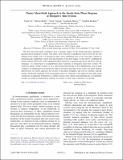Files in this item
Cluster mean-field approach to the steady-state phase diagram of dissipative spin systems
Item metadata
| dc.contributor.author | Jin, Jiasen | |
| dc.contributor.author | Biella, Alberto | |
| dc.contributor.author | Viyuela, Oscar | |
| dc.contributor.author | Mazza, Leonardo | |
| dc.contributor.author | Keeling, Jonathan | |
| dc.contributor.author | Fazio, Rosario | |
| dc.contributor.author | Rossini, Davide | |
| dc.date.accessioned | 2016-07-28T11:30:08Z | |
| dc.date.available | 2016-07-28T11:30:08Z | |
| dc.date.issued | 2016-09 | |
| dc.identifier | 244137952 | |
| dc.identifier | 7307d224-8739-444e-af8c-0f627e96a029 | |
| dc.identifier | 84992665961 | |
| dc.identifier | 000381471800001 | |
| dc.identifier.citation | Jin , J , Biella , A , Viyuela , O , Mazza , L , Keeling , J , Fazio , R & Rossini , D 2016 , ' Cluster mean-field approach to the steady-state phase diagram of dissipative spin systems ' , Physical Review X , vol. 6 , no. 3 , 031011 . https://doi.org/10.1103/PhysRevX.6.031011 | en |
| dc.identifier.issn | 2160-3308 | |
| dc.identifier.other | ArXiv: http://arxiv.org/abs/1602.06553v2 | |
| dc.identifier.other | ORCID: /0000-0002-4283-552X/work/27559410 | |
| dc.identifier.uri | https://hdl.handle.net/10023/9220 | |
| dc.description.abstract | We show that short-range correlations have a dramatic impact on the steady-state phase diagram of quantum driven-dissipative systems. This effect, never observed in equilibrium, follows from the fact that ordering in the steady state is of dynamical origin, and is established only at very long times, whereas in thermodynamic equilibrium it arises from the properties of the (free) energy. To this end, by combining the cluster methods extensively used in equilibrium phase transitions to quantum trajectories and tensor-network techniques, we extend them to nonequilibrium phase transitions in dissipative many-body systems. We analyze in detail a model of spin-1/2 on a lattice interacting through an XYZ Hamiltonian, each of them coupled to an independent environment that induces incoherent spin flips. In the steady-state phase diagram derived from our cluster approach, the location of the phase boundaries and even its topology radically change, introducing reentrance of the paramagnetic phase as compared to the single-site mean field where correlations are neglected. Furthermore, a stability analysis of the cluster mean field indicates a susceptibility towards a possible incommensurate ordering, not present if short-range correlations are ignored. | |
| dc.format.extent | 18 | |
| dc.format.extent | 1507727 | |
| dc.language.iso | eng | |
| dc.relation.ispartof | Physical Review X | en |
| dc.subject | QC Physics | en |
| dc.subject | DAS | en |
| dc.subject | BDC | en |
| dc.subject | R2C | en |
| dc.subject.lcc | QC | en |
| dc.title | Cluster mean-field approach to the steady-state phase diagram of dissipative spin systems | en |
| dc.type | Journal article | en |
| dc.contributor.sponsor | EPSRC | en |
| dc.contributor.institution | University of St Andrews. School of Physics and Astronomy | en |
| dc.contributor.institution | University of St Andrews. Condensed Matter Physics | en |
| dc.identifier.doi | https://doi.org/10.1103/PhysRevX.6.031011 | |
| dc.description.status | Peer reviewed | en |
| dc.identifier.grantnumber | EP/I031014/1 | en |
This item appears in the following Collection(s)
Items in the St Andrews Research Repository are protected by copyright, with all rights reserved, unless otherwise indicated.

